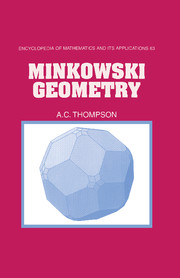Book contents
- Frontmatter
- Contents
- Preface
- Acknowledgements
- 0 The algebraic properties of linear spaces and convex sets
- 1 Norms and norm topologies
- 2 Convex bodies
- 3 Comparisons and contrasts with Euclidean space
- 4 Two-dimensional Minkowski spaces
- 5 The concept of area and content
- 6 Special properties of the Holmes–Thompson definition
- 7 Special properties of the Busemann definition
- 8 Trigonometry
- 9 Various numerical parameters
- 10 Fifty problems
- References
- Notation index
- Author index
- Subject index
Preface
Published online by Cambridge University Press: 05 May 2013
- Frontmatter
- Contents
- Preface
- Acknowledgements
- 0 The algebraic properties of linear spaces and convex sets
- 1 Norms and norm topologies
- 2 Convex bodies
- 3 Comparisons and contrasts with Euclidean space
- 4 Two-dimensional Minkowski spaces
- 5 The concept of area and content
- 6 Special properties of the Holmes–Thompson definition
- 7 Special properties of the Busemann definition
- 8 Trigonometry
- 9 Various numerical parameters
- 10 Fifty problems
- References
- Notation index
- Author index
- Subject index
Summary
In choosing a title for this volume I faced two problems. Firstly, should it be “Minkowski” or “Minkowskian Geometry”? Secondly, how could I avoid accusations of false advertising from students of relativity who expect Minkowski(an) geometry to deal with one time-like and several space-like dimensions?
In an attempt to resolve the first problem I made two very long lists, including the following items:
I then convinced myself that I detected two slight trends: the second list tended to predominate in more recent times, and this tendency was less pronounced in the applied or physical areas. My proposed solution to both problems is to suggest the use of Minkowski geometry for the present topic, i.e. the theory of finite dimensional normed linear spaces, which (as Dunford and Schwartz [130], p. 372, say) “is primarily due to Minkowski”, and to use Minkowskian geometry for that other creation of Minkowski's, the theory of linear spaces with an indefinite inner product. To the linguistic purists, I apologize for the juxtaposition of the terms Euclidean geometry and Minkowski geometry in several places.
Space to Euclid and Newton was uniform and “isotropic” – the same in all directions. Such a notion flies in the face of daily experience, where the connotation of “up” and “down” is different from that of “east” and “west”. There are preferred directions. Another good example is the preferred directions that cause crystals to grow as polyhedra and not spherically like soap-bubbles.
Information
- Type
- Chapter
- Information
- Minkowski Geometry , pp. ix - xivPublisher: Cambridge University PressPrint publication year: 1996
